Effects of Dietary Threonine Levels on Growth Performance, Biochemical Parameters, Muscle Quality, and Intestinal Microflora of Rice Field Eel (Monopterus albus)
Simple Summary
Abstract
1. Introduction
2. Materials and Methods
2.1. Experimental Design and Feed Preparation
2.2. Aquaculture Management
2.3. Sample Collection and Determination of Biochemical Indices
2.4. Calculation of Growth Performance and Morphological Parameters
2.5. Determination of Nutritional Components
2.6. Analysis of Muscle Texture Parameters
2.7. Measurement of Related Muscle Fiber Growth Gene Expression Levels
2.8. Analysis of Intestinal Tissue Structure
2.9. Analysis of Intestinal Microbiota
2.10. Data Processing and Analysis
3. Results
3.1. Growth Performance
3.2. Morphological Indices and Whole-Body Composition
3.3. Serum and Hepatic Biochemical Indices
3.4. Antioxidant Indices in the Liver, Intestine, and Muscle
3.5. Analysis of Muscle Texture Parameters
3.6. Expression Levels of Genes Related to Myofiber Growth
3.7. Intestinal Digestive Enzyme Activities
3.8. Intestinal Histomorphology
3.9. Intestinal Microbial Diversity
3.10. Composition and Differential Analysis of Gut Microbiota
3.11. Correlation Analysis
3.12. KEGG Functional Prediction Analysis of Gut Microbiota
4. Discussion
4.1. Comparing the Effects of Different Levels of Threonine on Growth Performance
4.2. Analysis of Whole-Body Composition and Muscle Quality
4.3. Biochemical Analysis of Serum, Liver, Intestinal, and Muscular Parameters
4.4. Analysis of Intestinal Digestive Enzyme Activity and Histomorphology
4.5. Analysis of Gut Microbiota
5. Conclusions
Author Contributions
Funding
Institutional Review Board Statement
Informed Consent Statement
Data Availability Statement
Acknowledgments
Conflicts of Interest
References
- Yang, D.Q.; Chen, F.R.; Guo, L. Effects of dietary choline supplementation on growth, tissue fat content, and digestive enzyme activity in rice-field eels. J. Fish. 2006, 5, 676–682. [Google Scholar]
- Houlihan, D.F.; Carter, C.G.; Mccarthy, I.D. Chapter 8 protein synthesis in fish. Biochem. Mol. Biol. Fishes 1995, 4, 191–220. [Google Scholar] [CrossRef]
- Peng, K.; Chen, B.; Zhao, H.; Wang, Y.; Zheng, C.; Lu, H.; Huang, M.; Zhao, J.; Huang, W. Reevaluation of dietary condensed tannins on growth, antioxidant and immune response and muscle quality of Chinese seabass (Lateolabrax maculatus). Aquaculture 2022, 558, 738413. [Google Scholar] [CrossRef]
- Wu, Y.; Tian, S.; Yuan, J.; Zhang, Z.; Zhou, H.; Gao, W.; Zhang, W.; Mai, K. Effects of Clostridium autoethanogenum protein as substitute for dietary fishmeal on the growth, feed utilization, intestinal health and muscle quality of large yellow croaker Larimichthys crocea. Aquaculture 2022, 561, 738591. [Google Scholar] [CrossRef]
- Xiao, Q.Z.; Feng, Y.; An, G.Z.; Jing, Y.C.; Ben, J.Y.; Lin, G. Nutritional Requirement of Lysine for Young Turtle. J. Fish. China 2001, 25, 454–459. [Google Scholar]
- Coloso, R.M.; Murillo-Gurrea, D.P.; Borlongan, I.G.; Catacutan, M.R. Sulphur amino acid requirement of juvenile Asian Sea bass Lates calcarifer. J. Appl. Ichthyol. 2001, 15, 54–58. [Google Scholar] [CrossRef]
- Ren, H.; Zhan, X.A. Research progress on amino acid nutrition in aquatic animals. Feed Res. 2006, 2, 41–43. (In Chinese) [Google Scholar]
- He, Z.G. Large Yellow Croaker (Pseudosciaena crocea R.) and Bass (Lateolabrax japonicus) Threonine and Phenylalanine Nutritional Physiology Studies. Master’s Thesis, Ocean University of China, Qingdao, China, 2008. (In Chinese) [Google Scholar] [CrossRef]
- Mizanur, R.M.; Li, X.; Sharifuzzaman, S.; He, M.; Leng, X. Dietary threonine requirement of juvenile largemouth bass, Micropterus salmoides. Aquaculture 2021, 543, 736884. [Google Scholar] [CrossRef]
- Ahmed, I. Dietary amino acid l-threonine requirement of fingerling Indian catfish, Heteropneustes fossilis (Bloch) estimated by growth and biochemical parameters. Aquac. Int. 2007, 15, 337–350. [Google Scholar] [CrossRef]
- Hu, X.X. Threonine Requirements of Grass Carp in the Middle Growth Period were Studied. Master’s Thesis, Sichuan Agricultural University, Yaan, China, 2012. [Google Scholar]
- Bai, Z.Z.; Liu, M.Y.; Li, S.H.; Lin, H.; Lin, L.; Li, R. Effects of threonine content in feed on Jian carp (Cyprinus Carpio Var. jian) meat quality and cathepsin B and L. Food Ferment. Ind. 2019, 45, 7. (In Chinese) [Google Scholar] [CrossRef]
- Zhao, Y.; Jiang, Q.; Zhou, X.Q.; Xu, S.X.; Feng, L.; Liu, Y.; Jiang, W.D.; Jiang, J. Effect of dietary threonine on growth performance and muscle growth, protein synthesis and antioxidant-related signalling pathways of hybrid catfish Pelteobagrus vachelli♀× Leiocassis longirostris♂. Br. J. Nutr. 2020, 123, 121–134. [Google Scholar] [CrossRef]
- Gao, Y.J.; Yang, H.J.; Liu, Y.J.; Chen, S.J.; Guo, D.Q.; Yu, Y.Y.; Tian, L.X. Effects of graded levels of threonine on growth performance, biochemical parameters and intestine morphology of juvenile grass carp Ctenopharyngodon idella. Aquaculture 2014, 424, 113–119. [Google Scholar] [CrossRef]
- Michelato, M.; Vidal, L.V.O.; Xavier, T.O.; Graciano, T.S.; Furuya, W.M. Dietary threonine requirement to optimize protein retentionand fillet production of fast-growing Nile tilapia. Aquac. Nutr. 2015, 22, 759–766. [Google Scholar] [CrossRef]
- Habte-Tsion, H.M.; Ren, M.; Liu, B.; Ge, X.; Xie, J.; Chen, R. Threonine modulates immune response, antioxidant status and gene expressions of antioxidant enzymes and antioxidant-immune-cytokine-related signaling molecules in juvenile blunt snout bream (Megalobrama amblycephala). Fish Shellfish Immunol. 2016, 51, 189–199. [Google Scholar] [CrossRef] [PubMed]
- Chen, Y.P.; Cheng, Y.F.; Li, X.H.; Yang, W.L.; Wen, C.; Zhuang, S.; Zhou, Y.M. Effects of threonine supplementation on the growth performance, immunity, oxidative status, intestinal integrity, and barrier function of broilers at the early age. Poult. Sci. 2017, 96, 405–413. [Google Scholar] [CrossRef] [PubMed]
- Dong, X.Y.; Azzam, M.M.M.; Zou, X.T. Effects of dietary threonine supplementation on intestinal barrier function and gut microbiota of laying hens. Poult. Sci. 2017, 96, 3654–3663. [Google Scholar] [CrossRef]
- Alam, M.S.; Teshima, S.; Koshio, S.; Yokoyama, S.; Ishikawa, M. Optimum dietary threonine level for juvenile Japanese flounder Paralichthys olivaceus. Asian Fish. Sci. 2003, 16, 175–184. [Google Scholar] [CrossRef]
- Habte-Tsion, H.M.; Liu, B.; Ren, M.; Ge, X.; Xie, J.; Zhou, Q.; Miao, L.L.; Pan, L.; Chen, R. Dietary threonine requirement of juvenile blunt snout bream (Megalobrama amblycephala). Aquaculture 2015, 437, 304–311. [Google Scholar] [CrossRef]
- Wang, Z.; Zhang, Z.Y.; Han, Y.P.; Zhang, Y.Y.; Wang, Y.L.; Yan, S.H. Analysis of the impact of cultivating water hyacinth in the large water areas of Dianchi Lake on water quality. J. Environ. Eng. 2012, 6, 3827–3832. (In Chinese) [Google Scholar]
- Meng, F.S.; Zhang, S.; Su, S.L.; Liu, J.M.; Liang, M.; Li, H.; Guo, J.; Gong, L.L. National Standard of the People’s Republic of China: Animal Feeding Stuff—Determination of Crude Moisture (GB/T 6435-2014); China Standards Press: Shanghai, China, 2014. [Google Scholar]
- Xiao, Z.M.; Fan, X.; Ma, D.X.; Li, L.B.; Wang, S.; Jia, Z.; Liu, X.X.; Wang, Z.G.; Liu, J. National Standard of the People’s Republic of China: Determination of Crude Protein in Feeds—Kjeldahl Method (GB/T 6432-2018); China Standards Press: Shanghai, China, 2018. [Google Scholar]
- Zhang, S.; Li, L.P.; Fan, Z.Y.; Yang, S.M.; Su, X.O. National Standard of the People’s Republic of China (GB/T 6433-2006); China Standards Press: Shanghai, China, 2016. [Google Scholar]
- Wu, R.L.; Yang, L.; He, Y.F.; Qian, L.; Zhong, M.; Yang, A.H.; Zhang, C.F. National Standard of the People’s Republic of China: Animal Feeding Stuff—Determination of Crude Ash (GB/T 6438-2007); China Standards Press: Shanghai, China, 2007. [Google Scholar]
- Eggers, D.M. Some recent methods for estimating food-consumption by fish-reply. J. Fish. Res. Board Can. 1979, 36, 1018–1019. [Google Scholar]
- Yue, Y.; Zou, Z.; Zhu, J.; Li, D.; Xiao, W.; Han, J.; Yang, H. Dietary threonine requirement of juvenile Nile tilapia, Oreochromis niloticus. Aquac. Int. 2014, 22, 1457–1467. [Google Scholar] [CrossRef]
- Tulli, T.F. Dietary threonine requirement of juvenile European sea bass (Dicentrarchus labrax). Aquaculture 1999, 175, 155–166. [Google Scholar] [CrossRef]
- Ryu, B.; Shin, K.; Kim, S. Muscle protein hydrolysates and amino acid composition in fish. Mar. Drugs 2021, 19, 377. [Google Scholar] [CrossRef] [PubMed]
- Teshima, S.; Alam, M.S.; Koshio, S.; Ishikawa, M.; Kanazawa, A. Assessment of requirement values for essential amino acids in the prawn, Marsupenaeus japonicus (Bate). Aquac. Res. 2010, 33, 395–402. [Google Scholar] [CrossRef]
- Small, B.C.; Soares, J.H. Quantitative Dietary Threonine Requirement of Juvenile Striped Bass Morone saxatilis. J. World Aquac. Soc. 1999, 30, 319–323. [Google Scholar] [CrossRef]
- Boren, R.S.; Gatlin, D.M. Dietary Threonine Requirement of Juvenile Red Drum Sciaenops ocellatus. J. World Aquac. Soc. 1995, 26, 279–283. [Google Scholar] [CrossRef]
- Zhu, J.; Wang, J.X. Comparison of general nutritional composition and protein amino acid composition of several carp muscles. J. Zhanjiang Ocean. Univ. 2000, 20, 4. (In Chinese) [Google Scholar] [CrossRef]
- Zhou, X.H.; Xiang, X.L.; Wen, H.; Zhao, H.P. Requirement of threonine in feed for Jifu tilapia. Freshw. Fish. 2014, 44, 7. (In Chinese) [Google Scholar] [CrossRef]
- Feng, L.; Peng, Y.; Wu, P.; Hu, K.; Jiang, W.D.; Liu, Y.; Jiang, J.; Li, S.H.; Zhou, X.Q.; Merrifield, D. Threonine affects intestinal function, protein synthesis and gene expression of tor in jian carp (Cyprinus carpio var. Jian). PLoS ONE 2013, 8, e69974. [Google Scholar] [CrossRef]
- Liao, Y.Q.; Wu, Y.R.; Du, Q.; Lin, H.M.; Zhang, B.; Deng, S.G.; Zhou, X.M. Analysis and evaluation of muscle quality and nutritional composition of fresh and air-dried hairtail. Food Ferment. Ind. 2023, 49, 185–191. (In Chinese) [Google Scholar] [CrossRef]
- Ian, A.; Richard, A.; Claire, S.; Alistair, D.; David, M.; Craig, S.; David, N.; Remi, B.; Billy, R.; David, W.; et al. Muscle fibre density in relation to the color and texture of smoked Atlantic salmon (Salmo salar L.). Aquaculture 2000, 189, 335–349. [Google Scholar] [CrossRef]
- Jiang, Q.Q. Effects of Adding Threonine in Feed on Growth Performance, Muscle Quality and Intestinal Health of Procambarus clarkii. Master’s Thesis, Shanghai Ocean University, Shanghai, China, 2024. (In Chinese) [Google Scholar] [CrossRef]
- Knutsen, H.R.; Ottesen, O.H.; Palihawadana, A.M.; Sandaa, W.; Sørensen, M.; Hagen, Ø. Muscle growth and changes in chemical composition of spotted wolffish juveniles (Anarhichas minor) fed diets with and without microalgae (Scenedesmus obliquus). Aquac. Rep. 2019, 13, 100175. [Google Scholar] [CrossRef]
- Gung, W.J.; Zhu, Y.F.; Chen, Z.D. Relationship between fish muscle fiber characteristics and fish meat quality. Fish. Sci. 2008, 27, 101–104. (In Chinese) [Google Scholar] [CrossRef]
- Johnston, I.A.; Bower, N.I.; Macqueen, D.J. Growth and the regulation of myotomal muscle mass in teleost fish. J. Exp. Biol. 2011, 214 Pt 10, 1617–1628. [Google Scholar] [CrossRef] [PubMed]
- Kavitha, C.; Ramesh, M.; Kumaran, S.S.; Lakshmi, S.A. Toxicity of Moringa oleifera seed extract on some hematological and biochemical profiles in a freshwater fish, Cyprinus carpio. Exp. Toxicol. Pathol. 2012, 64, 681–687. [Google Scholar] [CrossRef]
- Ji, K.; He, J.; Liang, H.; Ren, M.; Ge, X.; Masagounder, K. Response of gibel carp (Carassius auratus gibelio) to increasing levels of dietary lysine in zero fish meal diets. Aquac. Nutr. 2021, 27, 49–62. [Google Scholar] [CrossRef]
- Liang, L.W.; Zhou, L.T.; Zhou, Q.B.; Wang, Z.R.; Yang, Z.Q.; Huang, G.H. Effects of dietary lysine levels on growth performance, biochemical indices, and genes related to protein metabolism in juvenile rice field eels (Monopterus albus). Acta Hydrobiol. Sin. 2024, 49, 032510. [Google Scholar] [CrossRef]
- Ma, Z.Y.; Zhou, X.M.; Xie, S.Q.; Hua, D. Dietary phenylalanine requirement of juvenile Allogynogenetic crucian carp. Acta Hydrobiol. Sin. 2010, 34, 1012. [Google Scholar] [CrossRef]
- Cui, Y.T.; Liu, B.; Xie, J.; Xu, P.; Habte-Tsion, H.M.; Zhang, Y.Y. The effect of emodin on cytotoxicity, apoptosis and antioxidant capacity in the hepatic cells of grass carp (Ctenopharyngodon idellus). Fish. Shellfish Immunol. 2014, 38, 74–79. [Google Scholar] [CrossRef]
- Jiang, W.D.; Wena, H.L.; Liu, Y.; Jiang, J.; Wu, P.; Zhao, J.; Kuang, S.Y.; Tang, W.N.; Zhang, Y.A. Enhanced muscle nutrient content and flesh quality, resulting from tryptophan, is associated with anti-oxidative damage referred to the nrf2 and tor signalling factors in young grass carp (Ctenopharyngodon idella): Avoid tryptophan deficiency or excess. Food Chem. 2016, 199, 210–219. [Google Scholar] [CrossRef]
- Liu, J.W.; Mai, K.S.; Xu, W.; Zhang, Y.J.; Zhou, H.H. Effects of dietary glutamine on survival, growth performance, activities of digestive enzyme, antioxidant status and hypoxia stress resistance of half-smooth tongue sole (Cynoglossus semilaevis günther) post larvae. Aquaculture 2015, 446, 48–56. [Google Scholar] [CrossRef]
- Luo, J.B.; Feng, L.; Jiang, W.D.; Liu, Y.; Wu, P.; Jiang, J.; Kuang, S.Y.; Tang, L.; Tang, W.N.; Zhang, Y.A.; et al. Physical and flavor characteristics, fatty acid profile, antioxidant status and Nrf2-dependent antioxidant enzyme gene expression changes in young grass carp (Ctenopharyngodon idella) fillets fed dietary valine. PLoS ONE 2017, 12, e0169270. [Google Scholar] [CrossRef] [PubMed]
- Jobling, M. National research council (NRC): Nutrient requirements of fish and shrimp. Aquac. Int. 2012, 20, 601–602. [Google Scholar] [CrossRef]
- Kolkovski, S.; Tandler, A.; Kissil, G.W.; Gertler, A. The effect of dietary exogenous digestive enzymes on ingestion, assimilation, growth and survival of gilthead seabream (Sparus aurata, Sparidae, Linnaeus) larvae. Fish. Physiol. Biochem. 1993, 12, 203–209. [Google Scholar] [CrossRef]
- Hokin, L.E. Amino-acid requirements of amylase synthesis by pigeon-pancreas slices. Biochem. J. 1951, 50, 216. [Google Scholar] [CrossRef]
- Silva, L.C.R.; Furuya, W.M.; Santos, L.D.D.; Santos, V.G.D.; Silva, T.S.D.C.E.; Pinsetta, P.J. Threonine levels in diets for Nile tilapia. Rev. Bras. Zootec. 2006, 35, 1258–1264. [Google Scholar] [CrossRef]
- Wang, Y.L. Study on the Requirements of Threonine and Arginine in Triploid Rainbow Trout for Diets with Low Fish Meal. Master’s Thesis, Shanghai Ocean University, Shanghai, China, 2022. (In Chinese) [Google Scholar] [CrossRef]
- Fan, C.W. The Effect of Clostridium Butyricum on the Intestinal Health of Procambarus clarkii. Master’s Thesis, Huazhong Agricultural University, Wuhan, China, 2020. (In Chinese) [Google Scholar] [CrossRef]
- Lin, D.X.; Tang, Z.; Cai, M.L.; Xie, K.; Hu, Y. Effects of adding methionine in low-protein diet on growth performance, liver health and intestinal flora of Monopterus albus. Acta Hydrobiol. Sin. 2025, 49, 78–88. Available online: https://link.cnki.net/urlid/42.1230.q.20250114.1504.002 (accessed on 1 January 2025). (In Chinese).
- Yamazaki, Y.; Meirelles, P.M.; Mino, S.; Suda, W.; Oshima, K.; Hattori, M.; Thompson, F.L.; Sawabe, T. Individual Apostichopus japonicus fecal microbiome reveals a link with polyhydroxybutyrate producers in host growth gaps. Sci. Rep. 2016, 6, 21631. [Google Scholar] [CrossRef]
- Hamer, H.M.; Jonkers, D.; Venema, K.; Vanhoutvin, S.; Troost, F.J.; Brummer, R. Review article: The role of butyrate on colonic function. Aliment. Pharmacol. Ther. 2008, 27, 104–119. [Google Scholar] [CrossRef]
- LÜ, H.F.; Wang, H.; Xu, N.; Ju, J.S.; Liu, J. Effects of exogenous arginine on the growth and fermentation performance of Corynebacterium glutamicum under high glucose stress. Microbiol. China 2017, 44, 2539–2546. (In Chinese) [Google Scholar] [CrossRef]
- Yang, X.; Chen, H.; Gao, Y.; Wu, N.; Xue, D. Endophytic microbiome of Sphagnum palustre as indicators of ecosystem response to nitrogen depositionn. Environ. Technol. Innov. 2025, 38, 104122. [Google Scholar] [CrossRef]
- Prini, L.; Burtscher, J.; Sacken, P.; Krajnc, T.; Domig, K.J. Clostridium strain fam25158, a unique endospore-forming bacterium related to clostridium tyrobutyricum and isolated from emmental cheese shows low tolerance to salt. Front. Microbiol. 2024, 15, 14. [Google Scholar] [CrossRef]
- Yang, X.U.; Jiang, Y.; Hou, J.L.; Li, J.; Feng, X.L.; Liu, X.H.; Li, D.L.; Xiang, J.G.; Li, J.H. Dysplasia and torticollis on the skin microbiota of chinese spiny frog at the stage of complete metamorphosis. J. Hydrobiol. 2024, 48, 839. [Google Scholar] [CrossRef]
- Zhang, Y.; Zhang, X.; Cao, D.; Yang, J.; Mao, H.; Sun, L.; Wang, C. Integrated multi-omics reveals the relationship between growth performance, rumen microbes and metabolic status of Hu sheep with different residual feed intakes. Anim. Nutr. 2024, 18, 284–295. [Google Scholar] [CrossRef]
- Yu, M.J.; Yang, H.; Yu, C.S.; Cai, J.M.; Bu, Z.L.; Cai, X.W. Analysis on differences of microbial community structure and main flavor substances of Cyprinus carpio var. Jinbei cultured in paddy fields and ponds. South China Fish. Sci. 2023, 19, 151–163. [Google Scholar]


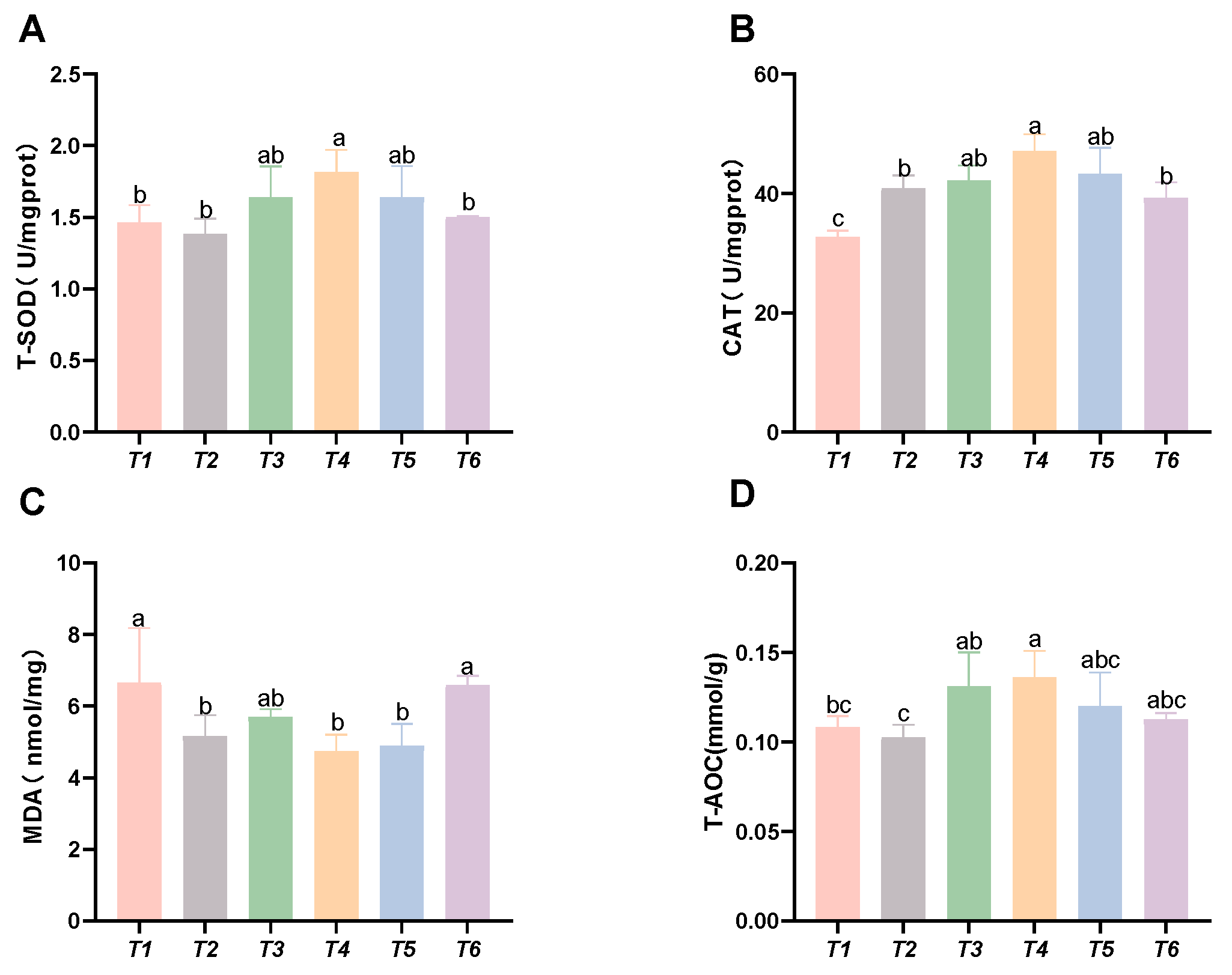

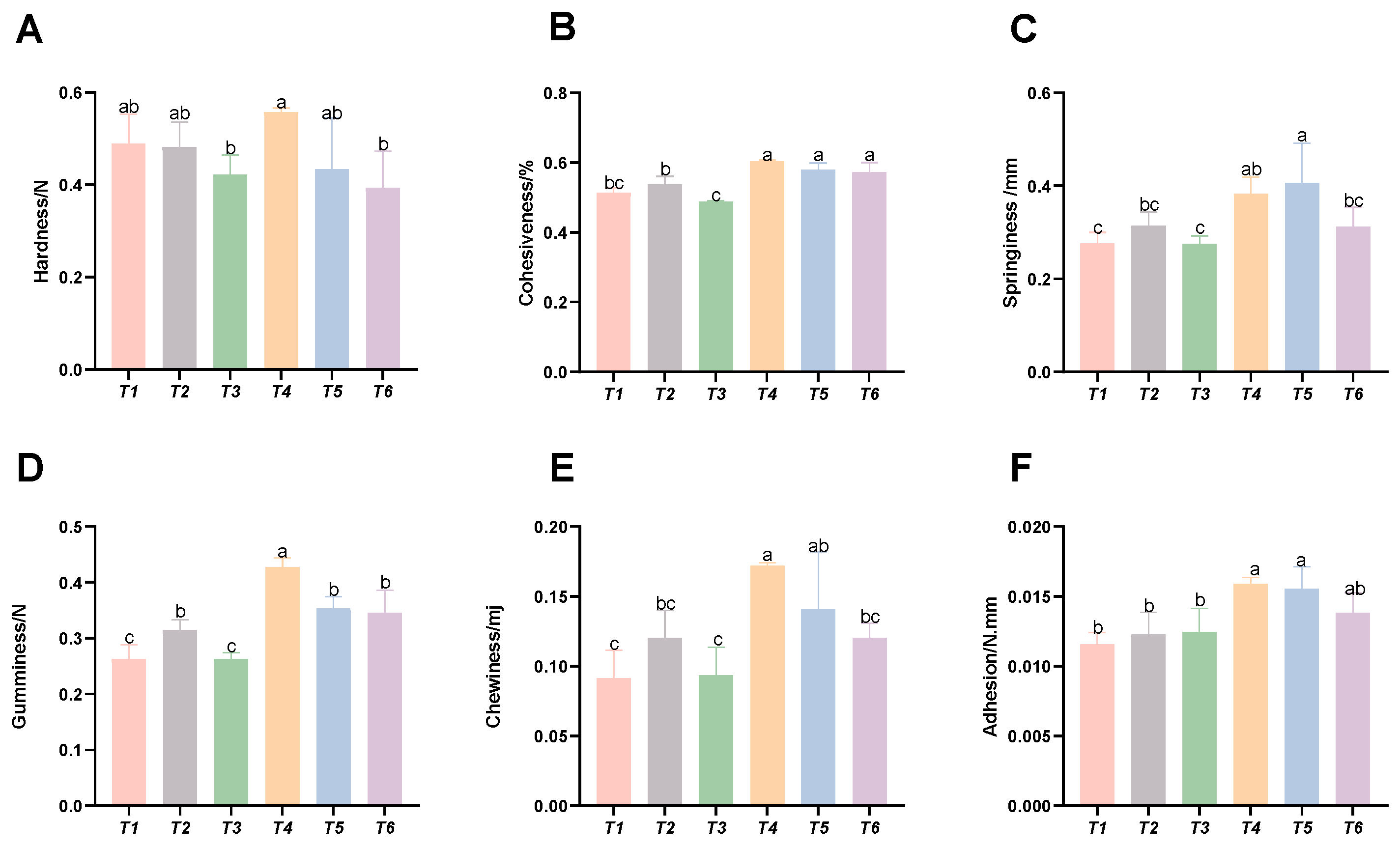




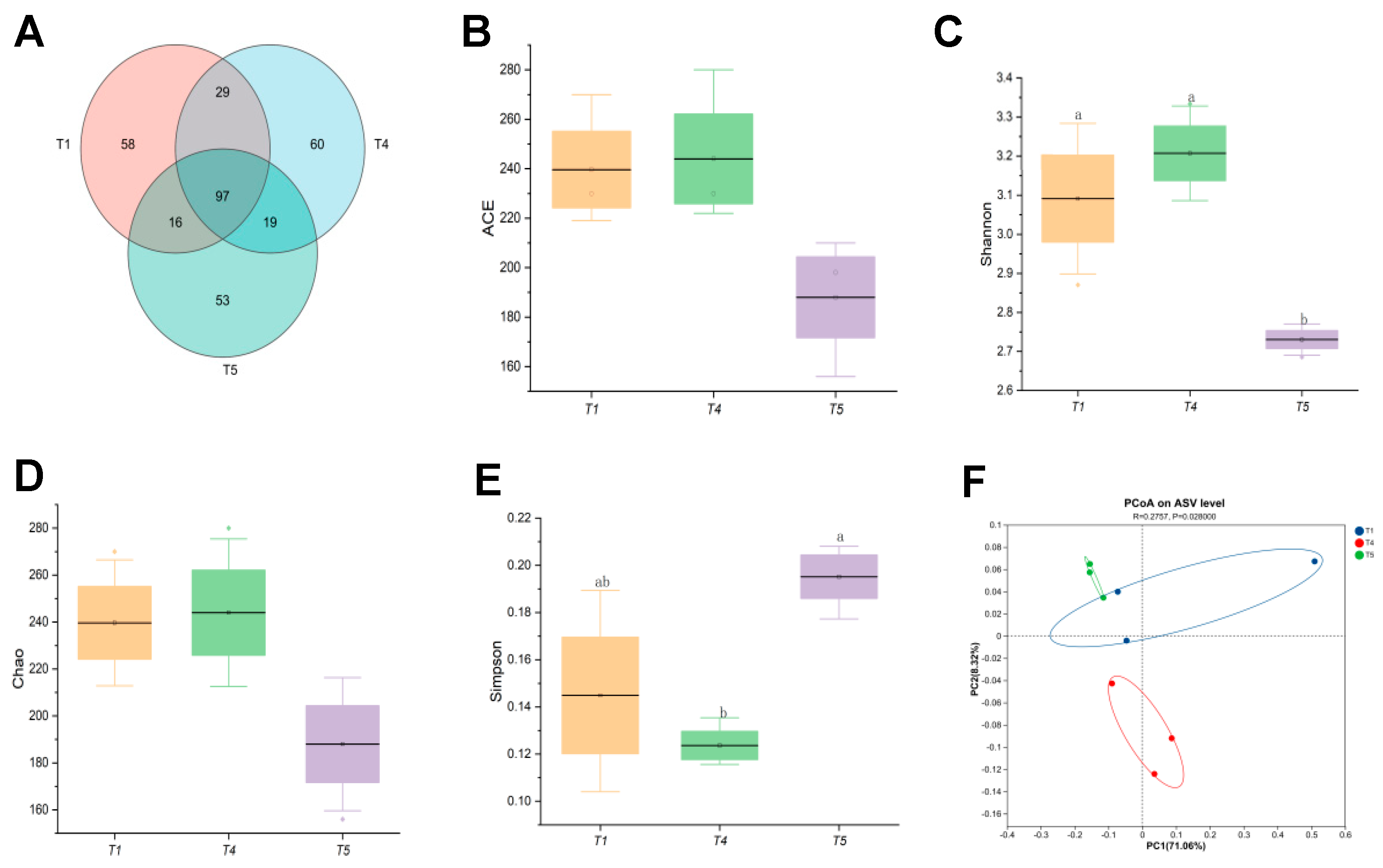
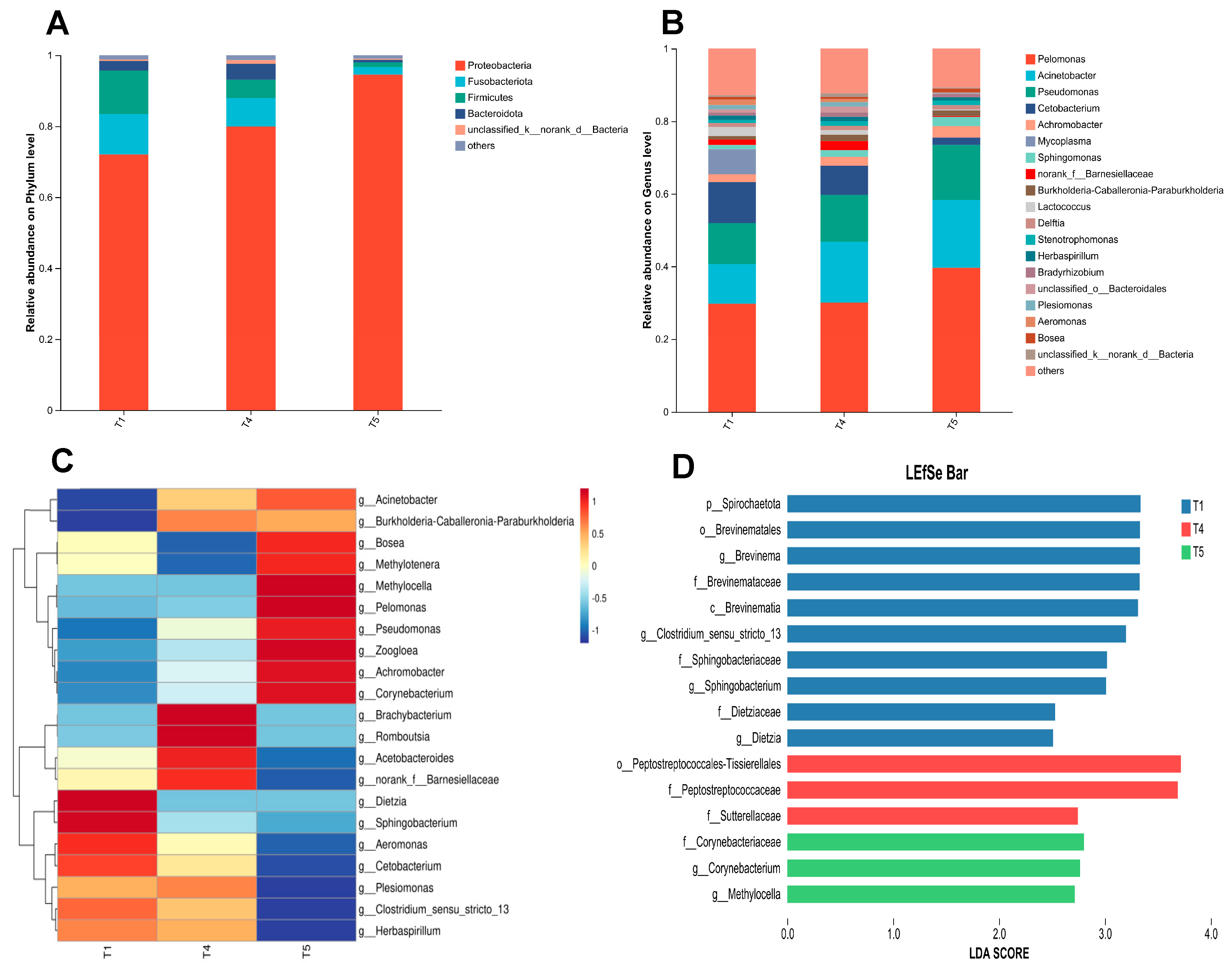
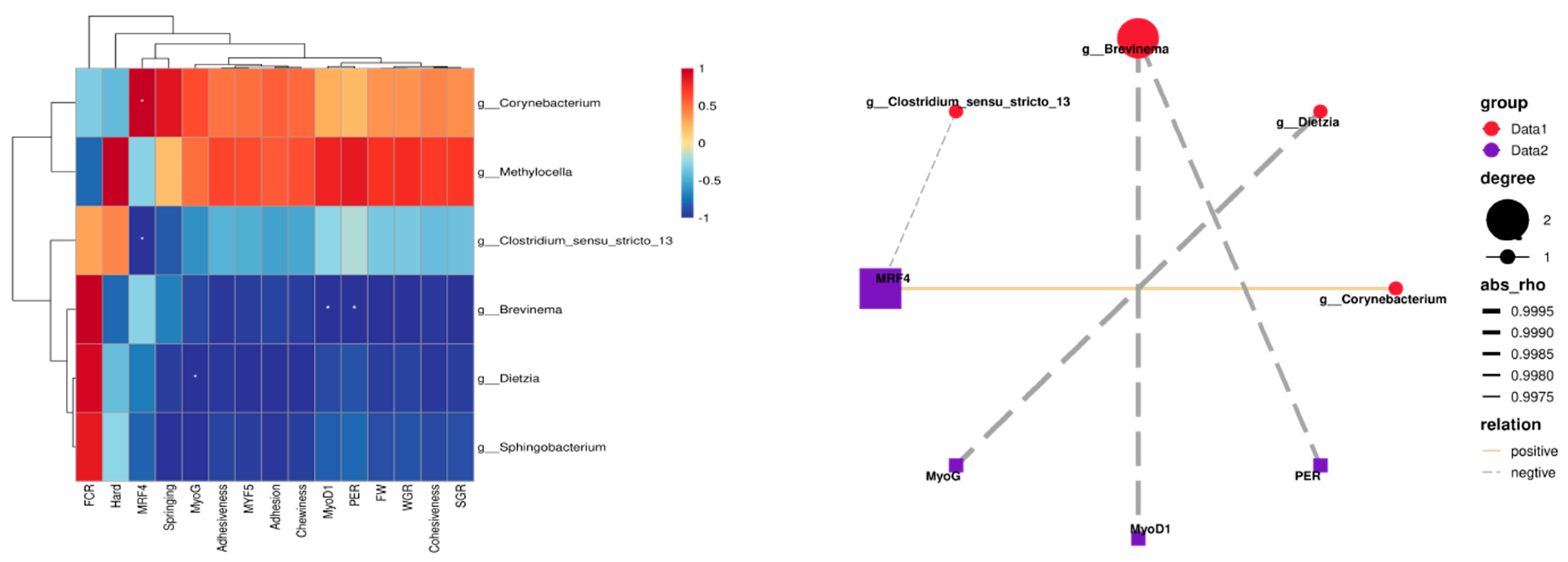
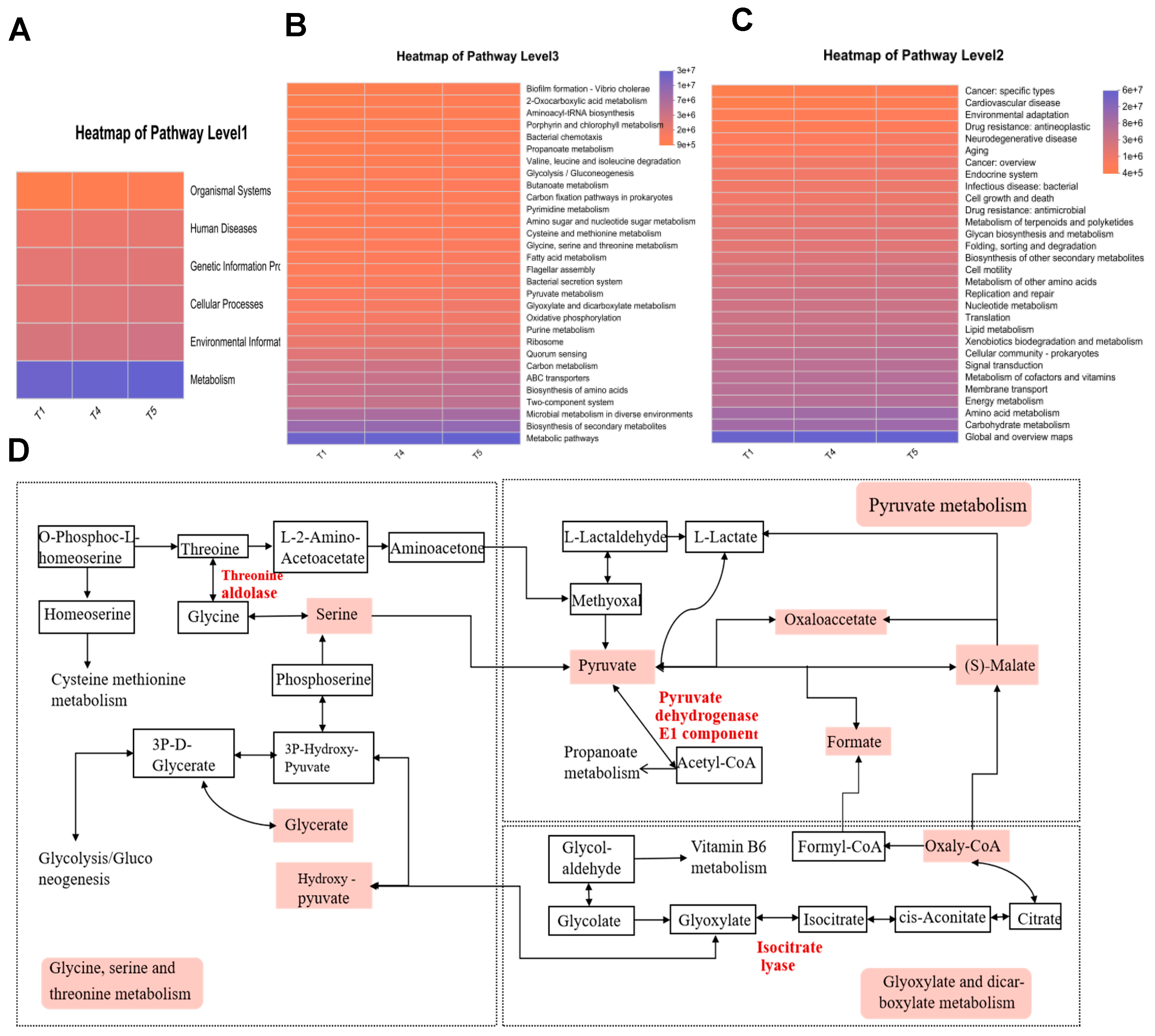
| Ingredient | T1 | T2 | T3 | T4 | T5 | T6 |
|---|---|---|---|---|---|---|
| Fish meal | 15 | 15 | 15 | 15 | 15 | 15 |
| Soy protein concentrate | 5 | 5 | 5 | 5 | 5 | 5 |
| Peanut meal | 30 | 30 | 30 | 30 | 30 | 30 |
| Corn protein powder | 25 | 25 | 25 | 25 | 25 | 25 |
| Fish oil | 3.6 | 3.6 | 3.6 | 3.6 | 3.6 | 3.6 |
| Soybean lecithin | 2 | 2 | 2 | 2 | 2 | 2 |
| Wheat meal | 8.1 | 8.1 | 8.1 | 8.1 | 8.1 | 8.1 |
| Amino acid mix 1 | 7.3 | 7.3 | 7.3 | 7.3 | 7.3 | 7.3 |
| Choline chloride | 0.5 | 0.5 | 0.5 | 0.5 | 0.5 | 0.5 |
| Ca(H2PO4) | 1 | 1 | 1 | 1 | 1 | 1 |
| Mineral premix 2 | 0.5 | 0.5 | 0.5 | 0.5 | 0.5 | 0.5 |
| Vitamin premix 3 | 0.5 | 0.5 | 0.5 | 0.5 | 0.5 | 0.5 |
| Threonine | 0 | 0.3 | 0.6 | 0.9 | 1.2 | 1.5 |
| Glycine | 1.5 | 1.2 | 0.9 | 0.6 | 0.3 | 0 |
| Total | 100 | 100 | 100 | 100 | 100 | 100 |
| Nutrient levels | ||||||
| Crude protein | 47.86 | 47.08 | 47.12 | 47.79 | 47.53 | 47.64 |
| Ash | 10.59 | 9.33 | 9.13 | 10.37 | 10.40 | 10.46 |
| Crude lipid | 5.69 | 5.34 | 5.36 | 5.39 | 5.43 | 5.50 |
| Gene Name | Primer Sequence (5′–3′) | Product Length (bp) |
|---|---|---|
| RPL17 | F: GTTGTAGCGACGGAAAGGGAC R: GACTAAATCATGCAAGTCGAGGG | 160 |
| MyoG | F: CGGCAACATTGAGGGAGA R: CTGCTGGTTCAGGGAGGA | 173 |
| MyoD1 | F: GGGATTGAGCATGGAGTTG R: GAGGAGGCGGTTGAAGA | 174 |
| MRF4 | F: GCTGGACGAACAGGAGAA R: GCAAGAGGCTGGAGGATG | 194 |
| MYF5 | F: CCGCAATGCCATTCAGTA R: TTATCGTCCAAACCCTCGT | 219 |
| Index | T1 | T2 | T3 | T4 | T5 | T6 |
|---|---|---|---|---|---|---|
| IW/g | 18.47 ± 0.65 | 18.57 ± 0.08 | 18.48 + 0.19 | 18.42 ± 0.039 | 18.40 ± 0.18 | 18.49 ± 0.10 |
| FW/g | 33.11 ± 0.46 d | 39.93 ± 0.39 c | 41.15 ± 0.99 b | 45.50 ± 0.74 a | 41.63 ± 0.24 b | 40.10 ± 0.09 c |
| FCR | 1.56 ± 0.04 a | 1.22 ± 0.05 b | 1.06 ± 0.01 d | 0.92 ± 0.01 e | 1.13 ± 0.03 c | 1.14 ± 0.01 c |
| WGR/% | 79.28 ± 2.08 d | 115.17 ± 2.05 c | 122.71 ± 4.54 b | 146.98 ± 3.53 a | 126.29 ± 0.83 b | 116.86 ± 1.32 c |
| SGR/%·d−1 | 0.97 ± 0.02 d | 1.28 ± 0.02 c | 1.33 ± 0.34 b | 1.51 ± 0.02 a | 1.36 ± 0.01 b | 1.29 ± 0.01 c |
| PER/% | 134.19 ± 3.75 e | 174.12 ± 6.83 d | 200.78 ± 1.26 b | 226.30 ± 1.70 a | 186.70 ± 4.33 c | 183.79 ± 1.90 c |
| Index | T1 | T2 | T3 | T4 | T5 | T6 |
|---|---|---|---|---|---|---|
| CF (g/cm3) | 0.09 ± 0.01 | 0.09 ± 0.01 | 0.08 ± 0.01 | 0.10 ± 0.05 | 0.09 ± 0.01 | 0.09 ± 0.01 |
| VSI (%) | 4.87 ± 0.63 a | 4.07 ± 0.47 b | 3.56 ± 0.68 b | 3.71 ± 1.15 b | 3.94 ± 0.89 b | 3.75 ± 1.16 b |
| HSI (%) | 8.45 ± 0.81 a | 7.82 ± 0.85 ab | 7.36 ± 1.09 b | 7.41 ± 1.33 b | 7.56 ± 1.05 ab | 7.35 ± 2.02 b |
| Index | T1 | T2 | T3 | T4 | T5 | T6 |
|---|---|---|---|---|---|---|
| Moisture (%) | 67.61 ± 1.54 b | 68.76 ± 0.12 b | 68.66 ± 4.00 b | 65.92 ± 2.11 b | 65.50 ± 2.15 b | 72.87 ± 0.27 a |
| Crude protein (%) | 52.02 ± 0.18 c | 48.06 ± 0.57 d | 53.99 ± 0.32 b | 55.53 ± 0.87 a | 50.94 ± 0.47 c | 55.11 ± 0.34 ab |
| Crude lipid (%) | 43.13 ± 1.09 b | 50.95 ± 1.97 a | 36.86 ± 7.19 cd | 33.03 ± 0.73 d | 42.60 ± 3.17 bc | 31.30 ± 0.24 d |
| Ash (%) | 8.15 ± 0.59 bc | 6.85 ± 0.23 d | 7.69 ± 0.17 cd | 8.71 ± 0.09 b | 7.14 ± 0.04 d | 11.13 ± 1.02 a |
| Index | T1 | T2 | T3 | T4 | T5 | T6 |
|---|---|---|---|---|---|---|
| Serum | ||||||
| TP (g/L) | 12.76 ± 5.8 b | 13.25 ± 4.29 b | 17.7 ± 3.13 ab | 21.69 ± 10.63 ab | 22.40 ± 10.23 ab | 31.80 ± 7.48 a |
| GOT (U/L) | 25.25 ± 1.06 ab | 28.5 ± 0.71 ab | 23.5 ± 2.12 ab | 22.5 ± 6.36 b | 28.00 ± 1.41 ab | 32.5 ± 4.95 a |
| GPT (U/L) | 5.00 ± 1.73 ab | 4.00 ± 1.00 ab | 3.33 ± 1.53 ab | 3.00 ± 1.41 b | 6.33 ± 1.53 a | 5.33 ± 1.53 ab |
| ALB (g/L) | 7.57 ± 2.66 ab | 6.61 ± 0.58 ab | 8.94 ± 2.6 ab | 5.51 ± 1.37 b | 5.63 ± 1.5 b | 10.33 ± 1.8 a |
| Liver | ||||||
| GOT (U/L) | 33.89 ± 3.97 b | 35.72 ± 3.69 b | 38.17 ± 0.85 b | 43.47 ± 1.46 a | 34.75 ± 3.82 b | 33.44 ± 2.32 b |
| GPT (U/L) | 35.17 ± 3.24 c | 36.64 ± 1.02 c | 53.40 ± 1.53 b | 57.88 ± 9.01 b | 42.12 ± 4.74 c | 66.70 ± 2.54 a |
Disclaimer/Publisher’s Note: The statements, opinions and data contained in all publications are solely those of the individual author(s) and contributor(s) and not of MDPI and/or the editor(s). MDPI and/or the editor(s) disclaim responsibility for any injury to people or property resulting from any ideas, methods, instructions or products referred to in the content. |
© 2025 by the authors. Licensee MDPI, Basel, Switzerland. This article is an open access article distributed under the terms and conditions of the Creative Commons Attribution (CC BY) license (https://creativecommons.org/licenses/by/4.0/).
Share and Cite
Yu, D.; Liu, Y.; Chen, J.; Wan, J.; Zhang, J.; Zhang, C. Effects of Dietary Threonine Levels on Growth Performance, Biochemical Parameters, Muscle Quality, and Intestinal Microflora of Rice Field Eel (Monopterus albus). Animals 2025, 15, 2643. https://doi.org/10.3390/ani15182643
Yu D, Liu Y, Chen J, Wan J, Zhang J, Zhang C. Effects of Dietary Threonine Levels on Growth Performance, Biochemical Parameters, Muscle Quality, and Intestinal Microflora of Rice Field Eel (Monopterus albus). Animals. 2025; 15(18):2643. https://doi.org/10.3390/ani15182643
Chicago/Turabian StyleYu, Denghang, Yujia Liu, Jiaxiang Chen, Jincheng Wan, Jiaqi Zhang, and Chi Zhang. 2025. "Effects of Dietary Threonine Levels on Growth Performance, Biochemical Parameters, Muscle Quality, and Intestinal Microflora of Rice Field Eel (Monopterus albus)" Animals 15, no. 18: 2643. https://doi.org/10.3390/ani15182643
APA StyleYu, D., Liu, Y., Chen, J., Wan, J., Zhang, J., & Zhang, C. (2025). Effects of Dietary Threonine Levels on Growth Performance, Biochemical Parameters, Muscle Quality, and Intestinal Microflora of Rice Field Eel (Monopterus albus). Animals, 15(18), 2643. https://doi.org/10.3390/ani15182643






